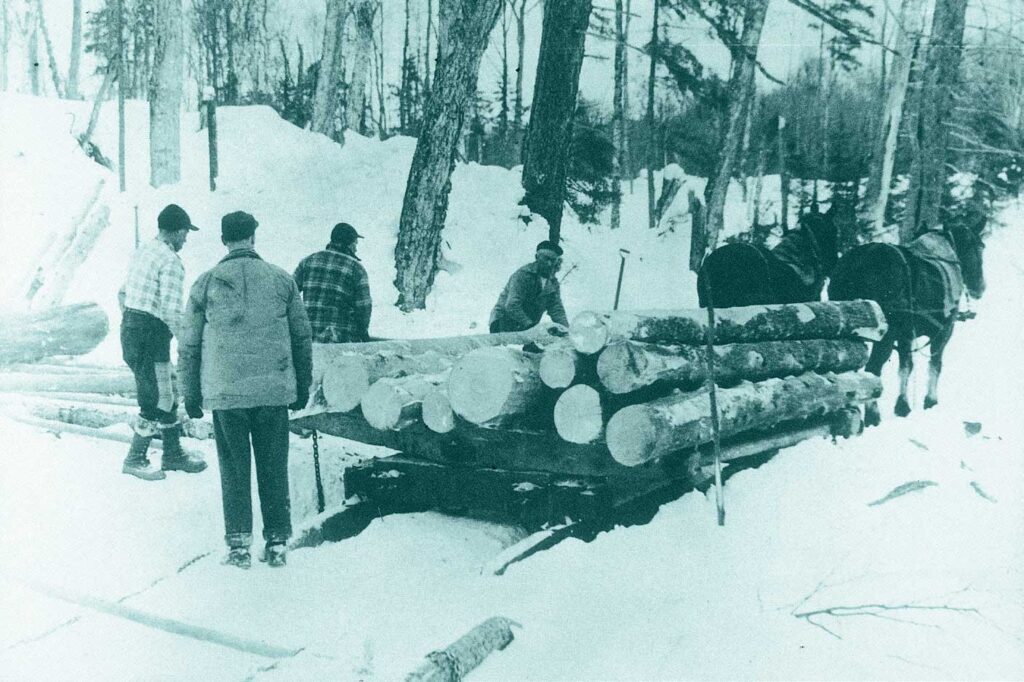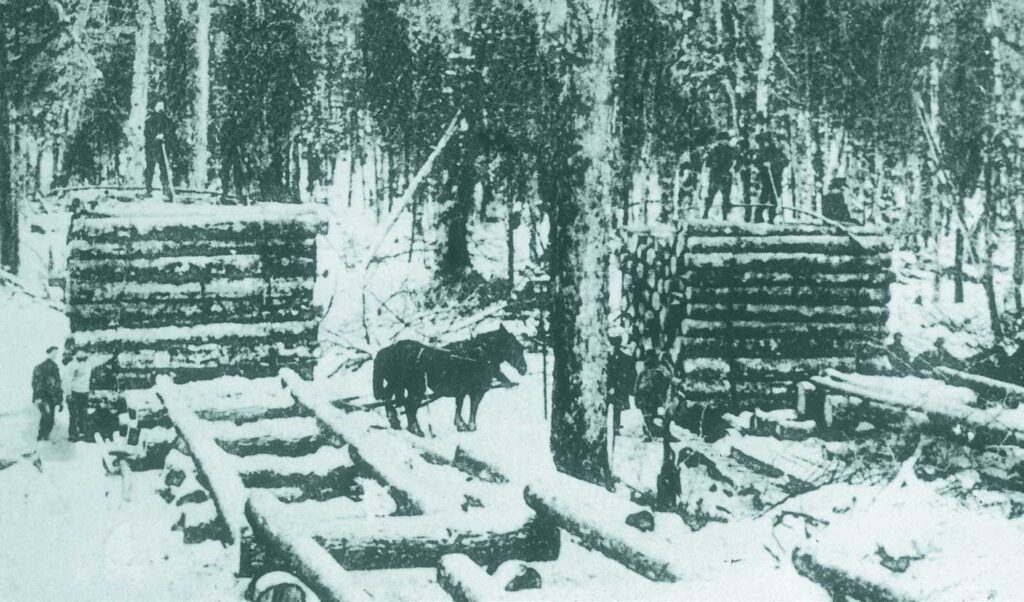Pat O’Brien grew up in the Adirondack North Country in the 1930s, when lumbering was still big business. The ring of the axe and the thundering crash of the giant trees …

A Look Back In Time
Published in The Northern Logger magazine, February 2024
I met Pat O’Brien in the fall of 1977 when I was invited to sit among a group of long-retired men, who earlier in their lives had a connection with the logging industry. The gathering place was Joe and Madge Conway’s home in Woodgate, New York.
I was there to witness the first of what came to be many other assemblages that were videotaped by Mary Teal. Teal was a long-time Lyons Falls History Association historian/archivist.

Old-time logging scenes shared at annual gatherings brought back memories that were shared with
a new generation.
Pat O’Brien was an exemplary conversationalist.
He enjoyed talking about his connection with log jobbers, truck drivers, white-water men, cooks and the meals they prepared, lumber camps – just about everything connected to the “lumber woods.”
O’Brien grew up in the Adirondack North Country in the 1930s, when lumbering was still big business. The ring of the axe and the thundering crash of the giant trees that punctuated the otherwise silent atmosphere in the virgin forest were strong in his memory.
I thought of him as a living encyclopedia of logging history. His knowledge was vast. He fielded many questions, including names, dates of events, details of lumbering companies, and so much more.
From him I picked up logging terms. “Corks” stood for calks – the sharp, pointed nails on soles and heels of river jacks’ boots. The needle-sharp points provided the dexterity for the “bubblewalkers” to “dance” from log-to-log, prodding thirteen-foot softwood logs with peaveys down through dangerous stretches of “white water” where a “catty” might “wash their clothes.”
But for all O’Brien’s forest industry information, he truly shined with his natural story-telling talent. Here’s how he described the unconventional outhouses:
They were not your regular variety. No individual seats but instead a peeled pole stretching across a dug trench where 10 to 15 men could sit together … across it. I recall this one camp I worked at had a number of awfully big men and it must have been the biggest man who had constructed the slit trench outhouse because he (Pat stretched as he demonstrated) was about as high as the peeled poles stood off the ground horizontally. I’d have to get a running leap to get up on it and you sure as shooting wanted to keep your balance and not slip off.
Since your feet couldn’t touch the ground, you’d have to concentrate on what you were doing because you sure as hell knew where you’d fall if you didn’t. And he described the men’s quarters in the lumber camps. “The smell of the bunkroom … well, nothing was worse.
You can’t imagine it where some 50 to 75 men lived and slept, with never really any chance to bathe thoroughly, launder their socks and clothing, bedding, whatever.”

Bed bugs and body lice were a recurring dilemma. It was the job of each ’jack to shake all the straw out of his personal cloth-covered mattress and boil the cover in one of the great black iron kettles also used to boil clothing. The covers were then refilled with new straw. “A deterrent for bed bugs was to spray the bunk bed boards with kerosene,” Pat said.
A pasty mixture of roofing tar and lard spread over one’s skin helped ward off mosquitoes and punkies. “Oh, and there was red lice. They come in under the wings of bats.” Pat joked, “I liked to go down to the big horse barns because they smelled so much better than the men’s camps.”
Log Drive:
– Original Poem by Pat O’Brien,
You or the Devil or God
If we go back in folklore
As we go back in our lives,
We always hear tell
Of the loose-living hell
Working the Moose River Drives.
Working the River was danger
During the break-up thaw,
Many men drowned
And never were found
Life on the River was raw.
Driving the wood on the River
To fill the company needs,
All in the name of progress,
Part of the rivermen’s breed.
Born to take neck-breaking chances,
Trained to take breath-taking rides;
Hard-working, hard-drinking woodsmen,
With genuine shoe leather hides.
Times were tough and so were the men.
The pay was two dollars and board.
The water was cold, the water was deep,
As the logs and the Moose River roared.
The River would drown you quick as a wink,
If your caulks didn’t hold in the log.
No man could save you, if you fell in,
It was you, or the devil, or God.
God wasn’t acquainted with many,
He scarcely knew a score,
But the devil knew all the rest,
He had seen them raise hell before.
It took a special breed of men
To take chances with their lives,
To get the logs to Lyons Falls,
On the Old Moose River Drive.
September 10, 1980
For all of Pat’s storytelling, he made it very clear that while the old days might seem exciting and colorful, l should have no illusion about the forestry industry. The work was hard, the hours were long and there was constant danger. In his later years, he worked for the Gould Paper Company and later as a scaler for Georgia Pacific at Lyons Falls, NY.
“I recall my son once telling me that he wanted to grow up and be a lumberjack just like me,” O’Brien told me. “I didn’t cotton to his admiration of my timber industry profession because of the long hours, hard dangerous work, and long periods away from home. I could have killed him!”
Pat didn’t pull any punches with me either.
Indeed, Pat was a gifted story teller right up to his death. He is the only person I know who insisted on two grave plots and stones. One stone has the typical inscription. For another burial plot, his headstone reads: “See, I told you I was sick.”

On my last visit with Pat, he handed me a typed copy of his original poem, “Log Drive: You or the Devil or God.” He told me the inspiration for the lines came to him on September 10, 1980 when he spotted a familiar old-timer’s gravestone on one of many walks he enjoyed taking through the “ground of memories.”
Pat had a “feeling” for the ’jacks of earlier days. His poem captures the risk and hard life involved in what he called “following the wood by water.” Each time I pass by the Constableville cemetery my thoughts drift back to him.
Pat O’Brien is highlighted in Chapter 29 of “Adirondack Logging: Life and Times in the Early Years of Logging’s Mechanization,” by William J. O’Hern.